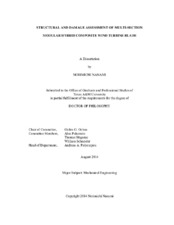| dc.contributor.advisor | Ochoa, Ozden O | |
| dc.creator | Nanami, Norimichi | |
| dc.date.accessioned | 2015-02-05T17:25:54Z | |
| dc.date.available | 2016-08-01T05:30:24Z | |
| dc.date.created | 2014-08 | |
| dc.date.issued | 2014-07-25 | |
| dc.date.submitted | August 2014 | |
| dc.identifier.uri | https://hdl.handle.net/1969.1/153418 | |
| dc.description.abstract | Wind energy is one of the most promising and mature alternatives to satisfy the global demand for energy as the world population and the economic activity surge. The wind energy market has grown rapidly in the last couple of decades, boosting up the size of wind turbines to generate higher power output. Typically, the larger/longer blade designs rely on hybrid material systems such as carbon and/or glass fiber (CF/GF) reinforced polymers to improve specific stiffness/strength and damage tolerance. In addition to the operational loads such as aerodynamic loads, the blade is also exposed to various impact scenarios such as hail damage and bird strike where safe operation and subsequent safe shut down are of significant importance.
Herein, we propose a computational design concept that includes a multi-section modular hybrid composite wind turbine blade with successful joints while maintaining structural integrity and stability requirements. The configuration of the blade will simplify manufacturing-assembly processes and reduce expenses both in transportation and facilities requirements. The large-scale single continuous wind turbine blade is modeled based on our model of an 80 m blade with sandwich skin, spar cap and shear web reinforcements. The 80 m single continuous blade is employed to distinguish potential damage modes when subjected to aerodynamic as well as impact loads. The
single continuous blade studies revealed that balsa core vs. foam core led to different damage initiation modes and that the blade provided sufficient damage tolerance below the operational loads associated with a wind speed of 8.9 m/s. Upon the 2 kg-bird impact in the vicinity of the blade tip, the blade with operational preloading conditions provided adequate impact resistance due to the absence of damage in the composite layers and the balsa core. Our study showed that the modular blade followed the single length blade response without any significant alterations to its structural response. It is concluded that the proposed computational design concept that allow two modular blades to create full-length blade with sufficient joints is achievable. This modular concept can be easily extended for further multi-section modular blade designs. | en |
| dc.format.mimetype | application/pdf | |
| dc.language.iso | en | |
| dc.subject | Modular blade | en |
| dc.subject | Large-scale wind turbine blades | en |
| dc.subject | CF/GF hybrid composite materials | en |
| dc.subject | Damage initiation and evolution | en |
| dc.subject | Bird strike | en |
| dc.subject | Finite element analyses | en |
| dc.title | Structural and Damage Assessment of Multi-Section Modular Hybrid Composite Wind Turbine Blade | en |
| dc.type | Thesis | en |
| thesis.degree.department | Mechanical Engineering | en |
| thesis.degree.discipline | Mechanical Engineering | en |
| thesis.degree.grantor | Texas A & M University | en |
| thesis.degree.name | Doctor of Philosophy | en |
| thesis.degree.level | Doctoral | en |
| dc.contributor.committeeMember | Palazzolo, Alan | |
| dc.contributor.committeeMember | Strganac, Thomas | |
| dc.contributor.committeeMember | Schneider, William | |
| dc.type.material | text | en |
| dc.date.updated | 2015-02-05T17:25:54Z | |
| local.embargo.terms | 2016-08-01 | |
| local.etdauthor.orcid | 0000-0002-5144-1610 | |


